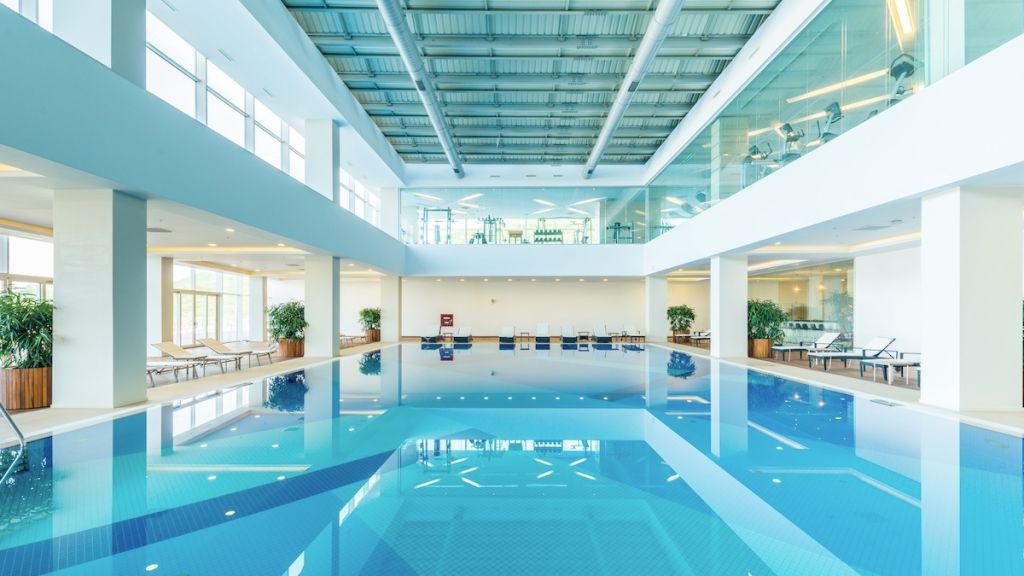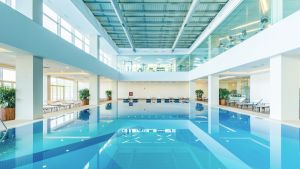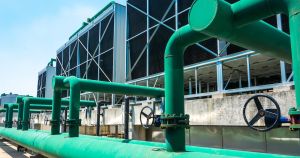When it comes to choosing the best UV pool sanitizer or AOP system for your aquatic facility, the decision goes beyond disinfection. Facility operators today are balancing water and air quality, energy efficiency, sustainability and cost.
This guide compares UV and AOP secondary sanitizers to help you determine which technology best fits your pool’s performance and budget goals.
Understanding UV Pool Sanitizer Technology
Ultraviolet (UV) systems have long been used in commercial indoor pools to help control the unhealthy by-products of chlorine disinfection. Combined chlorine, or chloramines, are chlorine-based Disinfection By-Products (DBPs) responsible for the odor, lung irritation and corrosion often associated with indoor pools.
UV pool technology uses high-intensity light to neutralize waterborne pathogens by disrupting their DNA and RNA, rendering them unable to reproduce. Although UV light splits chloramine molecules, the organics can recombine with chlorine later, reforming new chloramines and reducing long-term effectiveness. The result: air quality and chlorine by-products can still be an issue.
How UV Systems Work and Their Maintenance Needs
A UV sanitizer typically includes one or more mercury-based quartz lamps inside a cylindrical chamber. A hollow quartz sleeve separates the water from the lamp(s). Over time, minerals and metals create deposits on these sleeves – a process called fouling – which blocks UV energy from entering the water.
Calcium, aeration of water, dissolved metals such as iron or manganese, and high water temperature all accelerate fouling. Most systems include internal wipers, but they only remove some deposits. Eventually, operators must drain the system, remove the sleeves and hand-clean them. Manufacturers recommend service every 6 to 12 months, or more often in high-fouling environments.
Because servicing requires draining, most UV chambers are installed in a 100% bypass configuration with additional plumbing – adding cost and taking up valuable mechanical room space. The high cost of quartz lamps and sleeves often leads facilities to rely on contractors for maintenance, which can take 3–4 hours or more.
Typical UV considerations:
- Installation cost: $25,000–$70,000
- High energy use: medium-pressure UV wastes ~85% of consumed energy
- Annual energy bills: thousands of dollars (up to $10,000 for large pools)
- Maintenance: 3–4 hours of downtime, specialized service required
How Advanced Oxidation Process (AOP) Technology Works
Advanced Oxidation Process (AOP) pool sanitizer technology uses powerful hydroxyl radicals (•OH) – the most effective oxidizers found in nature – to destroy chloramines and their precursors before they bond with chlorine.
Hydroxyl radicals are naturally occurring in Earth’s lower atmosphere – there are millions around your headspace on a sunny day – constantly breaking down airborne pollutants.
These hydroxyl radicals form when monoatomic oxygen (O₁) is injected into water and reacts instantly with hydrogen from H₂O. Within one second, they oxidize organic compounds and chloramines, dramatically improving water and air quality.
Direct Injection AOP: Simplified Installation and Maintenance
While UV/ozone combination systems exist, ozone introduces added complexity, safety concerns and cost. Direct injection AOP eliminates those challenges.
Installation typically takes about one hour, requires no major plumbing changes and has a minimal footprint. Annual maintenance involves replacing a small cartridge inside a dry, wall-mounted cabinet – a task that can be done in minutes by facility staff.
Monoatomic oxygen is delivered through a microporous ceramic diffuser, and a built-in air gauge shows injection levels. If readings drop, organic buildup may be clogging the diffuser. A ten-minute muriatic acid soak restores normal flow.
Direct injection AOP advantages:
- Compact footprint: Installs in about one hour
- Low maintenance: Annual cartridge replacement by staff
- Low energy use: ~10% of a medium-pressure UV’s power draw
- Utility rebates: Commonly available through “custom incentive” programs
- Long-term ROI: Lower energy and chemical costs within 1–2 years
Comparing Cost, Efficiency and Performance
| Feature | UV Pool Sanitizer | Direct Injection AOP |
|---|---|---|
| Installation Cost | $25K–$70K | $14K–$36K |
| Energy Use | High (thousands/year) | Low (hundreds/year) |
| Maintenance | 3–4 hrs, specialized | Minutes, on-site |
| Oxidation Power | Low | High |
| Chloramine Control | Limited | Strong |
| DBP Reduction (THMs, HAAs) | Minimal | Proven |
| Chemical Reduction | None | 30–50% lower |
| Air Quality Improvement | Moderate | Significant |
| Rebates Available | Rare | Common |
Note: Values reflect industry averages and Clear Comfort field data; actual results vary by aquatic facility and operating conditions.
DBP and Chemical Reduction: The AOP Advantage
There are hundreds of chlorine Disinfection By-Products (DBPs) beyond chloramines. Chloramines are often regulated under local health codes, but many other DBPs remain unregulated despite their impact on air and water quality. Direct injection AOP effectively reduces Trihalomethanes (THMs) and Haloacetic Acids (HAAs) – the same DBPs regulated in drinking water.
By oxidizing organic contaminants before they combine with chlorine, AOP decreases chemical demand by 30–50% and increases Oxidation Reduction Potential (ORP). The result: clearer water, fewer chemicals and less irritation.
Standards and Secondary Disinfection
Direct injection AOP has been proven to disinfect Cryptosporidium, but the U.S. EPA’s Ultraviolet Disinfection Guidance Manual (UVDGM) only recognizes UV for secondary disinfection. While AOP meets or exceeds crypto inactivation levels, the current standard still favors UV until new testing protocols are adopted.
Indoor vs Outdoor Pools
UV pool sanitizers are rarely used outdoors since chloramine-related air issues naturally dissipate. AOP, however, provides measurable benefits for both indoor and outdoor pools by lowering chemical consumption, reducing DBPs and improving water quality.
All things equal, adding UV tends to increase chemical consumption, while AOP reduces it by up to 50%.
Real-World Cost Comparison: 165,000-Gallon Pool
To see how these differences translate into real operating costs, here’s a side-by-side look at a facility case study comparing Clear Comfort’s AOP system to a typical UV installation.
Key results:
- 60% lower annual operating costs with AOP vs UV
- 58% lower 5-year total cost of ownership
- Reduced chemical use, maintenance downtime, and energy consumption
Source: Clear Comfort TCO field analysis, 165,000-gallon pool.
When to Choose UV vs AOP
While AOP provides broader oxidation benefits, some facilities may still choose UV to meet specific compliance requirements. Because UV is referenced in the EPA’s Ultraviolet Disinfection Guidance Manual (UVDGM), it remains the standard for cryptosporidium inactivation in many health codes.
However, AOP pool systems exceed UV’s performance in nearly every other category – from energy efficiency and chemical reduction to maintenance simplicity and air quality improvement.
Facilities upgrading older UV systems often find that switching to direct injection AOP delivers rapid payback, lower operational costs and measurable improvements in swimmer comfort and staff safety.
Choosing the Right Secondary Sanitizer for Your Aquatic Facility
Both medium-pressure UV and direct injection AOP are recognized for addressing chloramines in pools, spas and splash pads. However, when considering installation cost, maintenance, operational simplicity and long-term energy savings, AOP offers a clear advantage.
If you’re facing an expensive UV repair, consider testing Clear Comfort AOP instead. With a 90-day money-back guarantee, your only risk is about one hour of installation labor. If it doesn’t outperform UV in air and water quality, energy efficiency and chemical reduction – return it for a full refund.
To learn more, schedule a quick 25-minute system review to explore how Clear Comfort AOP can help your facility operate cleaner, safer and more sustainably.
Find the right secondary sanitizer for your facility.
Schedule a quick system review to compare solutions and see what best fits your pool’s goals.



Tom Schaefer
Technical Sales Director



